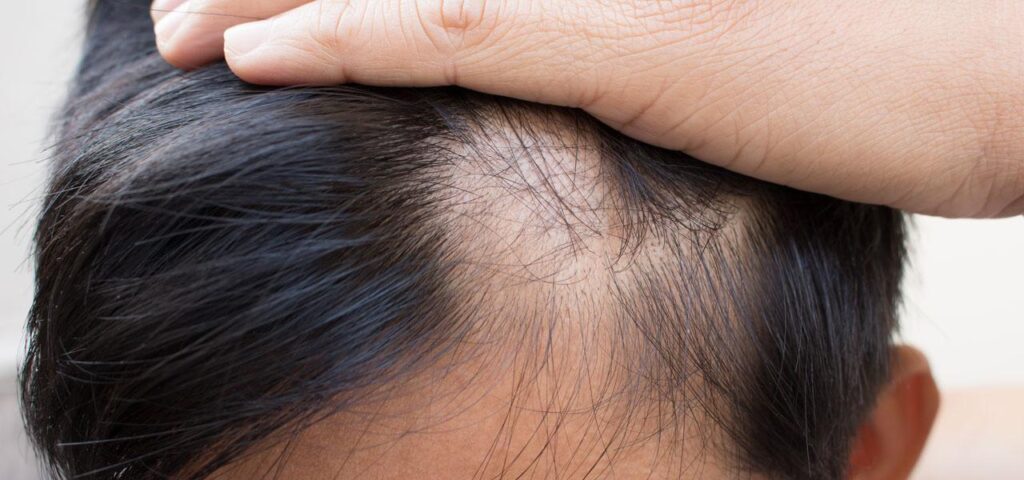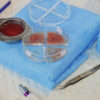Scarring alopecia is a disease, that leads to irreversible hair loss. Hair follicles are replaced by fibrous connective tissues and vitrified collagen. This disease was found only twenty years ago. Since then, many cases of this disease have been described as quite difficult to treat. Scarring alopecia occurs due to many causes and can be the result of serious systemic diseases or birth defects. This is a very rarely diagnosed type of baldness, which means not only hair loss, but also inflammation of the scalp. Hair follicles are irreversibly damaged, which leads to permanent alopecia of the affected area. It is worth looking at the causes, symptoms and further treatment of this rare disease.
Scarring alopecia: causes of the disease
This disease appears as a result of permanent damage of the hair follicles. Hair cannot grow, which as a result, gets lost. There are many causes of scarring baldness and we divide them into spontaneous or secondary factors. The causes of this disease also include the presence of various serious illnesses.

Genetic predispositions
The disease occurs at a young age and may be associated with the presence of serious autoimmune diseases. The immune system reacts incorrectly, which leads to aggression against its own body. This form of the disease develops due to hereditary factors. Diseases that can affect the development of scarring alopecia are:
- Darier’s disease,
- bullous epidermal separation,
- congenital hypoplasia of the skin,
- focal hypoplasia of cartilage.
Congenital scarring alopecia may be accompanied by other malformations, e.g. abnormal heart structure or spina bifida. Pathologies, associated with scarring, can not only affect the scalp, but also other parts of the body. Underdevelopment of cartilage leads to skin atrophy at a given area of the skin.
Irritations, injuries, infections and scarring alopecia
This type of alopecia can be a complication after bacterial, fungal or viral infections, that occurred locally. Examples of conditions that contribute to scarring baldness are shingles, boils or infections caused by dermatophytes. A skin infection will initiate inflammation, which will affect the hair follicles. The cells of the immune system also damage the healthy tissues and create scars. The resulting scar is an irreversible process; therefore, hair regeneration is impossible.
Physical factors are the most common causes of this disease. The response of the scalp to damage is practically the same as for scars in other places of the body. However, the scar on the head is more visible, because there is no hair on it. Physical factors include second- and third-degree burns, frostbite, chemical burns, electric current and various types of injuries.
Impact of autoimmune diseases
As a result of the local neoplastic process, hair loss may occur. It may also be cancer, which has spread to the scalp. Types of tumors that contribute to scarring are squamous cell carcinomas, hemangiomas and lymphomas, metastatic tumors and basal cell epitheliomas. By infiltrating the surrounding tissues, the tumor leads to tissue destruction and replaces them with scarred connective tissues.
Scarring alopecia
W wyniku powstania miejscowego procesu nowotworowego może dojść do utraty włosów. Może to być nowotwór, który ma przerzuty na skórę głowy. Rodzaje nowotworów, które przyczyniają się do bliznowacenia są raki kolczystokomórkowe, naczyniaki krwionośne i chłonne, guzy przerzutowe, nabłoniaki podstawnokomórkowe. Przez naciekanie na okoliczne tkanki nowotwór prowadzi do zniszczenia tkanek i zastąpienia ich zbliznowaciałą tkanką łączną.
Symptoms of scarring alopecia
The cell infiltration covers the entire structure of the hair follicle. The stem cells, that are in it, are destroyed. This means irreversible loss of regeneration and hair growth. Patients often report a burning sensation and itching of the scalp. Pain is also felt when touching the hair. In the early stages of this disease, there are also erythematous lesions and keratosis. These changes are located around the hair follicles. In problematic areas, hair loss can occur, which happens in different stages of growth. The disease usually occurs in the front-temporal region. Most often, baldness is quite slow. In some cases, the disease is aggressive and can affect many areas of the body.
Diagnosis of scarring alopecia
During the examination, the doctor will assess the appearance of the places where the hair falls out. It may be helpful to use a dermatoscope. The specialist will then notice the characteristic absence of hair follicle outlets. These outlets are overgrown by scars. Keratosis and erythema will also be noticeable. The final diagnosis is made by a histological examination, i.e. a biopsy of a skin fragment. The diagnosis can be supplemented with blood tests, which show the cause.
Treatment of this disease
The treatment causes many difficulties, because scarring alopecia is a whole group of pathologies. A proper treatment for this type of baldness is quite limited. A severe treatment is associated with irreversible damage to the hair follicles. The goal is to stop the progress and remove the cause of the disease.
Medication treatment
The goal of the prescribed medication is not to reverse the effects. The goal is to stop the progress of changes and remove the causes of this disease. For many patients, stopping the and eliminating the itching, is already a satisfactory effect. Pharmacotherapy is used primarily for infectious and inflammatory forms of this disease. Therefore, antifungal medication or antibiotics are used. In the case of scarring baldness, based on autoimmune diseases, an immunomodulatory treatment is used, which weakens the immune system.
Surgical treatment
In this case, aesthetic medicine doctors will participate. Surgical intervention is essentially the best treatment for this type of baldness. Your doctor may transplant your scalp or use a healthy hair follicle for transplantation. Surgical treatment is especially effective for young people. Their scars are usually stable and do not exceed 30% of the scalp.
Other treatments for scarring alopecia
One of the most popular methods to treat this disease is mesotherapy, i.e. the subcutaneous administration of appropriate nutrients. The nutrient mixture is administered by a cannula or a special gun. The doctor selects the type of mixture based on the patient’s state of health. Cryomassage is also a possibility. This treatment uses the properties of freezing, and its goal is biological regeneration. Good results are also brought by UVA / UVB therapy, which involves irradiating the scalp with rays.
When it comes to treating scarring alopecia, modern and professional trichological procedures are the most effective. The combination of several methods can provide a more effective treatment. With this disease, home remedies won’t be solution, because they will not stimulate the hair follicles to grow.





